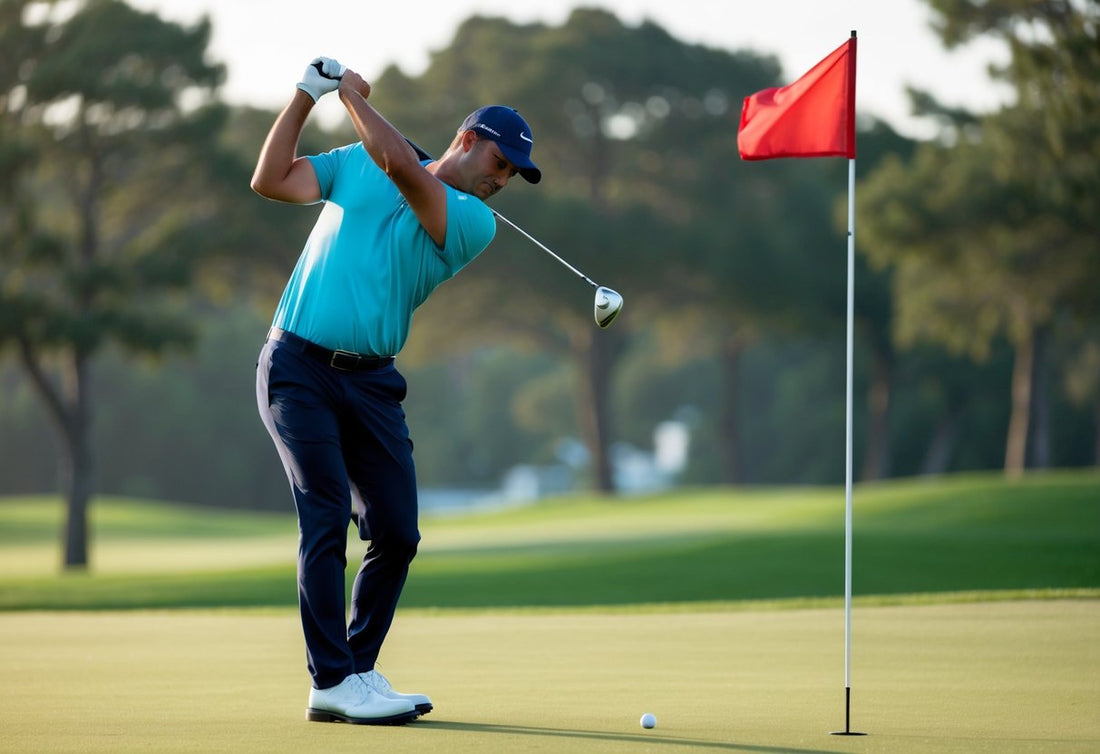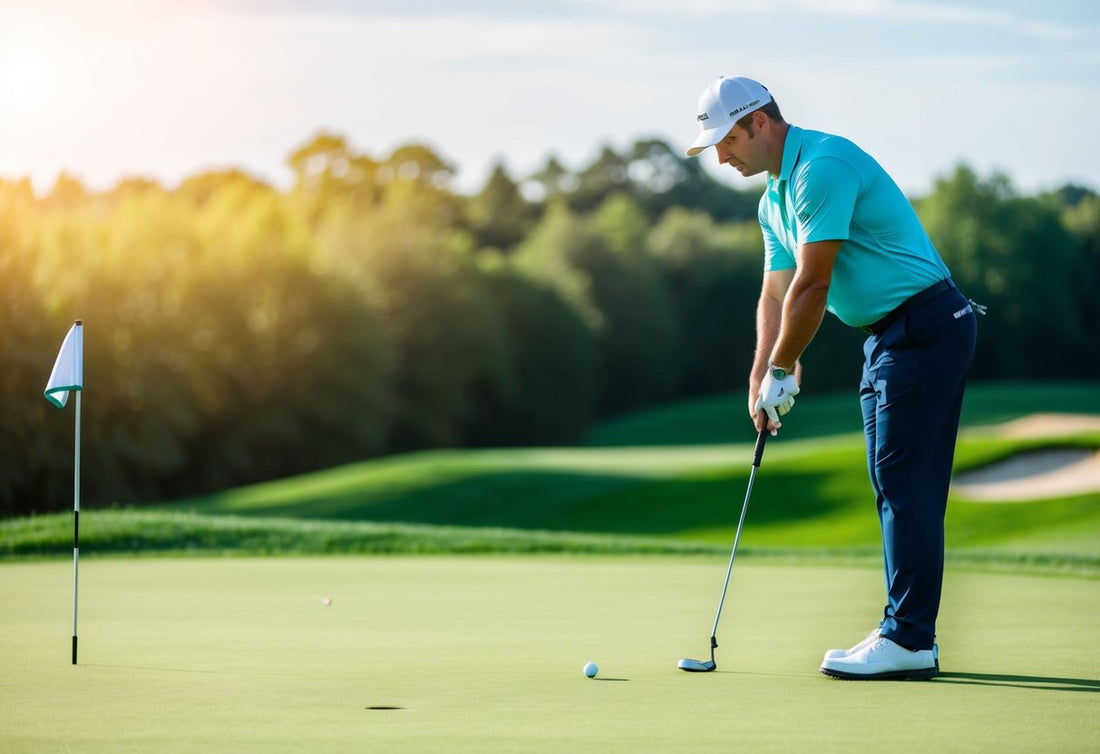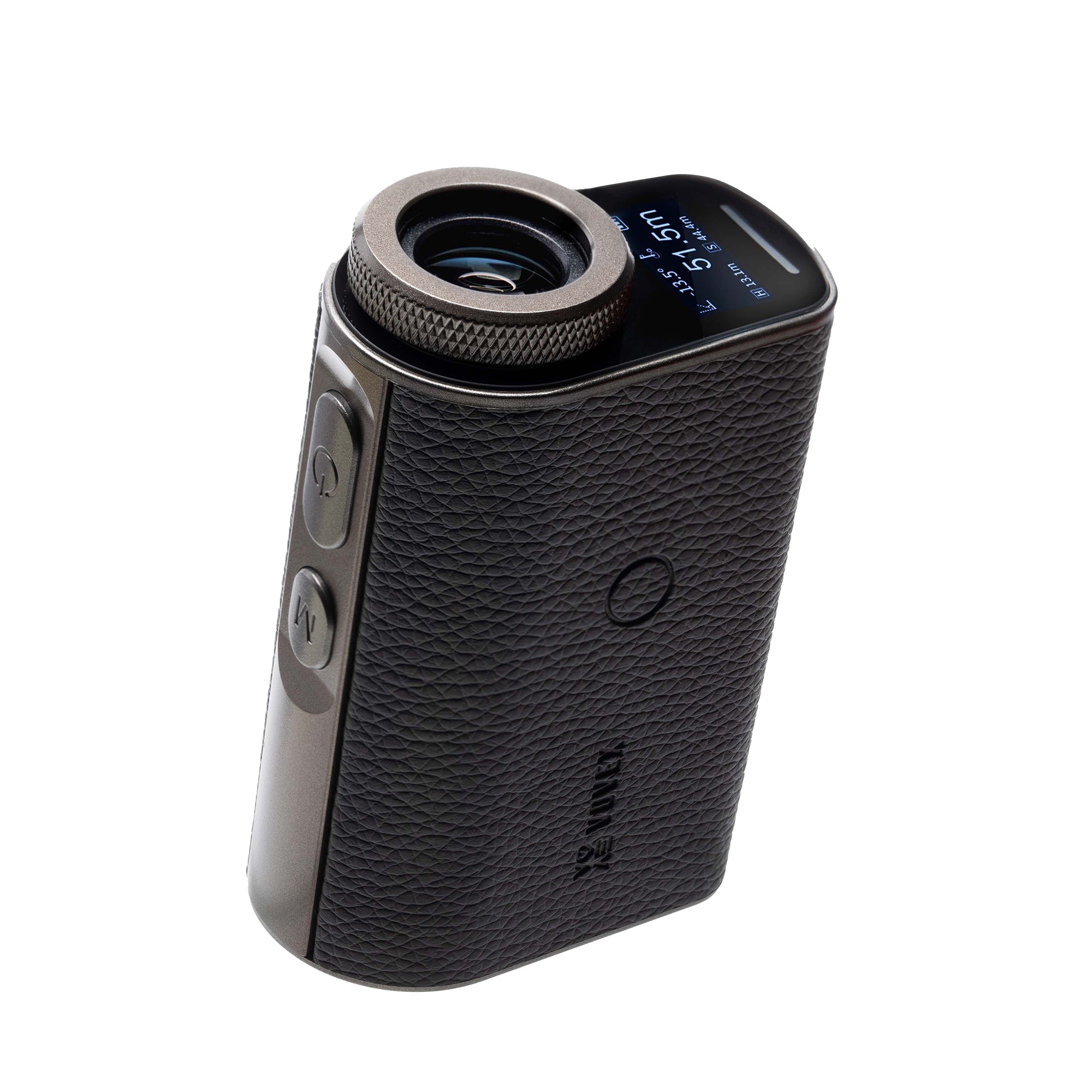Check out our golf rangefinders by Vovex to elevate your game!
Golf club refurbishing is a rewarding way to breathe new life into your beloved clubs. Whether you're looking to save money or simply enjoy a DIY project, restoring your golf clubs can improve their performance and appearance.
With the right tools and techniques, you can rejuvenate your clubs to look and feel like new without breaking the bank.
We've spent years perfecting the art of golf club restoration and want to share our expertise with fellow golf enthusiasts. In this guide, we'll walk you through the step-by-step process of refurbishing your golf clubs. From cleaning and refinishing to grip replacement and performance tuning, we'll cover everything you need to know to get your clubs back in top shape.
Get ready to roll up your sleeves and give your trusted clubs a makeover. By the end of this article, you'll have the knowledge and confidence to tackle your own golf club refurbishment project.
Key Takeaways
- Proper cleaning and refinishing can significantly improve club appearance and performance
- Replacing worn grips enhances comfort and control during your swing
- Regular maintenance extends the life of your refurbished golf clubs
Understanding the Basics of Golf Clubs
Golf clubs are essential tools for any player looking to improve their game. Each type serves a specific purpose on the course, with unique materials and designs enhancing performance.
Types of Golf Clubs
Woods are used for long-distance shots, typically off the tee or fairway. They have large heads and long shafts for maximum power. Irons are versatile clubs for a range of distances and situations. We use them for approach shots and tee shots on shorter holes.
Wedges are specialized irons for short, high-accuracy shots. They're crucial for getting out of tricky lies or hitting onto the green. Putters are designed for use on the green, helping us roll the ball into the hole with precision.
Hybrids combine features of woods and irons, offering forgiveness and versatility. They're great for players who struggle with long irons.
Materials and Design
Modern golf clubs use a variety of materials to enhance performance. Club heads are often made from titanium, steel, or composite materials. Titanium is lightweight and allows for larger club heads, increasing the sweet spot.
Shafts can be steel or graphite. Steel offers more control, while graphite is lighter and can increase swing speed. The flex of the shaft affects ball trajectory and distance.
Club face design is crucial for performance. Grooves on the face help with spin and control. Some clubs feature perimeter weighting to improve forgiveness on off-center hits.
Grip material and size impact our ability to control the club. We can choose from rubber, cord, or synthetic materials based on personal preference and playing conditions.
Assessing Your Golf Clubs
Before refurbishing your golf clubs, a thorough assessment is crucial. We'll examine how to identify wear and damage, as well as determine which clubs need refurbishing.
Identifying Wear and Damage
Let's start by inspecting the clubheads. Look for scratches, dents, or rust on the faces and soles. Check if the grooves are still sharp and clearly defined. Worn grooves can affect spin and control.
Next, examine the shafts. Run your hands along them to feel for any bends or cracks. Pay close attention to the hosel area where the shaft meets the clubhead.
Don't forget the grips. Are they smooth, slick, or cracking? Worn grips can significantly impact your swing and control.
For woods and hybrids, inspect the clubface for any cracks or cave-ins. These issues can affect performance and may require professional repair.
Determining Refurbishing Needs
Once we've identified wear and damage, it's time to decide what needs refurbishing. Create a checklist for each club:
- Clubhead: Does it need cleaning, polishing, or re-plating?
- Grooves: Do they need re-sharpening?
- Shaft: Is it bent and in need of straightening?
- Grip: Should it be replaced?
Consider the age and value of your clubs. Older, high-quality clubs often benefit more from refurbishing than newer, budget-friendly options.
Prioritize clubs you use most frequently. Your driver, wedges, and putter typically see the most action and may need attention first.
If you're unsure about the extent of damage or refurbishing needs, consult a professional club fitter or repair specialist for expert advice.
Gathering Your Refurbishing Tools and Materials
To refurbish golf clubs effectively, we'll need the right tools, safety gear, and supplies. Let's explore what's essential for a successful club makeover.
Essential Tools
We always start with a good set of screwdrivers. Flathead and Phillips head screwdrivers are crucial for removing and reattaching clubheads. A solid grip remover tool is indispensable for stripping old grips without damaging the shaft.
For cleaning, we rely on wire brushes and steel wool. These help remove rust and grime from clubheads and shafts. A buffing wheel attachment for a power drill speeds up the polishing process.
Don't forget a sharp utility knife for trimming new grips. A vice or clamp secures clubs while we work, making tasks easier and safer.
Safety Equipment
Safety glasses are a must-have. They protect our eyes from flying debris during cleaning and sanding. We always wear work gloves to guard against cuts and chemicals.
A dust mask is essential when sanding or working with chemicals. It keeps harmful particles out of our lungs. If using spray paint or solvents, we opt for a respirator for better protection.
Proper ventilation is key. We set up fans or work outdoors to avoid inhaling fumes. A first aid kit should be nearby for any minor injuries.
Refurbishing Supplies
New grips are often the first upgrade we consider. We choose from rubber, cord, or hybrid materials based on preferences. Grip tape and solvent are necessary for a secure installation.
For clubhead restoration, we use sandpaper in various grits. Coarse grits remove old finishes, while fine grits smooth surfaces for painting. Primer and specialized golf club paint ensure a durable, professional finish.
Epoxy is crucial for reattaching clubheads or fixing loose ferrules. We also keep shaft extenders and trimming tools on hand for length adjustments.
Cleaning solutions, metal polish, and microfiber cloths complete our refurbishing kit. These items help restore shine and remove stubborn dirt from all club surfaces.
Cleaning Techniques
Proper cleaning is essential for restoring golf clubs to their former glory. Let's explore effective methods for each component.
Club Heads
We start by soaking club heads in warm, soapy water for 15-20 minutes. This loosens dirt and grime, making scrubbing easier. A soft-bristled brush works wonders for removing debris from grooves and crevices.
For stubborn rust spots, we gently use steel wool or a specialized rust remover. Be careful not to scratch the club face. A mixture of vinegar and baking soda can also help tackle tough stains.
After cleaning, we rinse thoroughly with clean water and dry with a microfiber cloth. A final polish with metal polish restores shine to chrome or stainless steel club heads.
Shafts
We clean golf club shafts with a damp cloth and mild soap. For graphite shafts, extra care is needed to avoid damage. We use a soft, non-abrasive cloth to prevent scratching.
Stubborn dirt may require a gentle scrubbing with a soft-bristled brush. We always clean in the direction of the shaft's grain to maintain its integrity.
After cleaning, we dry the shafts completely with a clean towel. A light coat of shaft wax can protect against future dirt and oxidation, especially for steel shafts.
Grips
We begin by wiping down grips with a damp cloth to remove surface dirt. For deeper cleaning, we use warm, soapy water and a soft brush to gently scrub the grip surface.
Rubber grips benefit from a mixture of water and mild dish soap. For cord or wrap grips, we use a specialized grip cleaner to avoid damaging the material.
After cleaning, we rinse grips thoroughly and dry them with a clean towel. To restore tackiness, we apply a grip enhancer or rub with fine-grit sandpaper. This improves grip performance and extends its lifespan.
Removing Old Finishes and Paint
Before applying new finishes, we need to strip away the old paint and coatings. This process prepares the clubs for a fresh look and improved performance.
Stripping Techniques
We start by using a paint stripper specifically designed for metal surfaces. We apply it generously to the clubhead using a brush, ensuring full coverage. After letting it sit for 15-20 minutes, we gently scrape off the loosened paint with a plastic scraper.
For stubborn areas, we might need a second application. We're careful not to damage the metal underneath. For grooves and hard-to-reach spots, we use a small wire brush or toothbrush.
Once the bulk of the paint is removed, we switch to fine-grit sandpaper. We sand in circular motions to smooth out any remaining rough patches.
Preparation for Repainting
After stripping, thorough cleaning is crucial. We wipe down the clubhead with acetone or mineral spirits to remove any residue. This step ensures the new paint will adhere properly.
Next, we inspect the surface for any dents or scratches. Small imperfections can be filled with a metal epoxy filler. Once dry, we sand it smooth to blend with the rest of the surface.
We finish by wiping the clubhead with a tack cloth to remove any dust particles. This leaves us with a clean, smooth surface ready for primer and new paint.
Applying New Finishes
Refreshing the appearance of golf clubs can dramatically improve their look and feel. We'll explore techniques for painting club heads and rechroming shafts to give old clubs new life.
Painting Club Heads
We start by thoroughly cleaning the club heads with soap and water, then sanding them to create a smooth surface. Next, we apply a primer designed for metal surfaces. This step ensures better paint adhesion.
Once the primer dries, we apply the new paint in thin, even coats. Spray paint works well for a smooth finish. We use paints specifically formulated for golf clubs to withstand impacts and weather conditions.
After the paint dries, we add a clear coat for extra protection and shine. This step is crucial for longevity. We allow each layer to dry completely before handling or using the clubs.
Rechroming Shafts
Rechroming begins with removing the old chrome plating. We use a chemical stripper or sandblasting to expose the bare metal underneath. It's essential to work in a well-ventilated area and wear protective gear during this process.
Once stripped, we clean the shafts thoroughly to remove any residue. Next, we apply a layer of nickel plating as a base. This step improves the adhesion and durability of the chrome layer.
Finally, we electroplate the shafts with chrome. This process requires specialized equipment and expertise. The result is a brilliant, mirror-like finish that resists corrosion and wear.
After rechroming, we allow the shafts to cure fully before reassembling the clubs. Proper curing ensures the new finish will last for many rounds of golf.
Replacing Golf Club Grips
Replacing worn-out grips can significantly improve your golf game. New grips provide better traction and control, enhancing your overall performance on the course.
Choosing the Right Grips
When selecting new grips, we recommend considering factors like material, texture, and size. Rubber grips offer durability and all-weather performance, while cord grips provide excellent traction in wet conditions.
For comfort and reduced slippage, many players prefer softer materials like leather or synthetic compounds. Texture is crucial - rougher grips offer more traction but may wear out faster.
Grip size matters too. Oversized grips can help reduce hand action, while undersized ones allow for more wrist movement. We suggest trying different sizes to find what feels most comfortable and suits your playing style.
Installation Process
Installing new grips is a straightforward process that we can do at home with the right tools. First, we'll need a hook blade or utility knife to remove the old grip.
Next, we'll clean the shaft thoroughly and apply double-sided grip tape. Solvent or lubricating spray helps slide the new grip onto the shaft easily.
We'll align the grip properly and work out any air bubbles. It's important to let the grips dry completely before use, typically 6-8 hours.
For those less confident in their DIY skills, many golf shops offer professional grip installation services at reasonable prices.
Fine-Tuning Club Performance
Refurbishing golf clubs goes beyond cosmetic improvements. We'll explore key techniques to enhance your clubs' performance through precise adjustments and weighting modifications.
Adjusting Loft and Lie
Loft and lie angles significantly impact ball flight and accuracy. We use specialized tools to measure and adjust these angles. For loft adjustments, we carefully bend the clubhead to increase or decrease the angle, affecting trajectory and distance.
Lie angle modifications ensure the sole sits flat at impact. We use a lie board and impact tape to assess the current lie. Then, we bend the hosel to optimize the club's interaction with the turf.
These adjustments require precision. Even small changes can dramatically improve your shots' consistency and accuracy.
Balancing and Weighting
Club balance and weight distribution are crucial for optimal performance. We start by checking the swing weight, which affects how the club feels during your swing. Using a swing weight scale, we measure and adjust as needed.
Adding lead tape to specific areas of the clubhead can fine-tune weight distribution. This helps correct ball flight issues or enhance feel. For more permanent solutions, we might drill small holes in the clubhead and insert tungsten weights.
Shaft modifications also play a role. Trimming the shaft or adding tip weights can alter the club's overall balance and flex characteristics, tailoring it to your swing.
Caring for Your Refurbished Clubs
Proper maintenance and storage are crucial for keeping your refurbished golf clubs in top shape. Let's explore some key tips to ensure your clubs stay in excellent condition for years to come.
Routine Maintenance Tips
We recommend cleaning your clubs after each round of golf. Use warm, soapy water and a soft brush to remove dirt and debris from the clubheads and grips. Dry them thoroughly with a clean towel to prevent rust.
Regularly inspect your clubs for any signs of wear or damage. Check the grips for smoothness and replace them if they become slick or worn. Examine the clubheads for dents or cracks.
Keep your grooves clean and sharp. Use a groove cleaning tool to remove dirt and maintain optimal spin on your shots. For wooden clubs, apply a thin coat of linseed oil to protect the wood.
Storage Advice
Store your clubs in a cool, dry place to prevent moisture damage. A temperature-controlled environment is ideal. Avoid leaving them in your car trunk, as extreme temperatures can affect club performance.
Use headcovers to protect your woods and putter. This prevents dings and scratches when clubs bump against each other in the bag. Stand your bag upright to reduce stress on the shafts.
Consider using a club rack or organizer in your home. This keeps clubs separated and easy to access. If traveling, invest in a sturdy travel case to shield your clubs from rough handling.
Clean and dry your clubs before storing them for extended periods. Apply a light coat of mineral oil to the clubheads to prevent rust during long-term storage.
Frequently Asked Questions
Refurbishing golf clubs can breathe new life into your favorite set. We've compiled answers to common questions about the process, materials, and techniques.
How can I refinish my golf clubs at home?
We recommend starting with a thorough cleaning. Use warm soapy water and a soft brush to remove dirt and grime. For iron heads, light sanding can help smooth out scratches. Apply a thin coat of paint or clear finish for protection.
Always work in a well-ventilated area. Let each coat dry completely before adding another. Patience is key for achieving a professional-looking result.
What materials do I need to properly polish golf clubs?
A basic polishing kit should include fine-grit sandpaper, metal polish, microfiber cloths, and a buffing wheel. For deeper scratches, you might need coarser sandpaper to start.
Consider investing in a polishing compound specifically designed for golf clubs. It can help restore shine without damaging the club's surface.
Are there benefits to having my golf clubs professionally refinished?
Professional refinishing often yields superior results. Experts have access to specialized equipment and high-quality materials. They can address issues like shaft replacement or lie angle adjustments.
Pros can also match finishes precisely to manufacturer specifications. This can be crucial for maintaining a club's value or performance characteristics.
What's the best paint to use when restoring the appearance of my golf clubs?
We recommend using epoxy-based paints designed for golf clubs. These paints offer excellent durability and adhesion. They're resistant to chipping and fading, even with regular use.
Avoid regular spray paints, as they won't stand up to the rigors of golf. Always apply paint in thin, even coats for the best results.
Can I remove rust from golf club heads, and if so, how?
Yes, rust can often be removed from club heads. Start with a mixture of vinegar and water. Soak the rusty areas for about 30 minutes.
Use steel wool or a wire brush to gently scrub away loosened rust. For stubborn spots, try a commercial rust remover. Always rinse and dry the club thoroughly after treatment.
What steps should I follow to make my old golf clubs look brand new again?
Begin by disassembling the clubs if possible. Clean each component thoroughly. For iron heads, sand away scratches and imperfections.
Apply new paint or finish as needed. Polish metal surfaces to a high shine. Replace grips if they're worn. Reassemble carefully, ensuring all parts are secure.
Consider realigning and regrooving club faces for optimal performance. This step may require professional assistance for best results.






